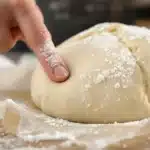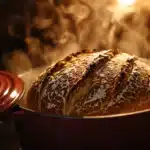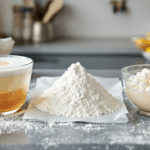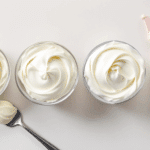Close your eyes and imagine the aroma of freshly baked cookies, the tender crumb of a perfect pound cake, or the shatteringly crisp layers of a croissant. What indispensable ingredient plays a starring role in creating these delightful experiences? Often, it’s butter. Fat, in general, is a cornerstone of baking, but butter holds a special place in the hearts (and recipes) of many bakers for its unique combination of flavor and functional properties.
But why is fat so important? And why are recipes so specific about using butter, and often dictating whether it should be cold, softened, or melted? For aspiring bakers, understanding the fundamental roles fat – particularly butter – plays is key to moving beyond simply following steps and starting to control the outcome. It influences everything from the richness and taste to whether your bake is flaky, tender, chewy, or light. Let’s delve into the basics of butter and explore why fat is far more than just a greasy ingredient; it’s a master architect of flavor and texture.
More Than Mouthfeel: The Functions of Fat (Especially Butter) in Baking
Fat is a powerhouse ingredient, contributing far more than just richness or preventing sticking. Here are its key functions in baking, with a special focus on butter:
- Flavor: This is where butter truly shines. Real butter imparts a distinct, rich, slightly sweet, and creamy flavor that is difficult to replicate with other fats like shortening or most oils. The specific flavor notes can even vary depending on the butter’s origin and whether it’s cultured. While other fats might be chosen for texture, butter is often chosen for taste.
- Tenderness: Fats tenderize baked goods primarily by interfering with gluten development. Fat molecules coat the proteins in flour, physically hindering their ability to link together and form long, strong gluten strands. This “shortening” effect (which is where vegetable shortening gets its name) results in a more tender, less chewy crumb structure. The higher the fat content, generally the more tender the result.
- Moisture & Richness: While fat itself isn’t water, it contributes significantly to the perception of moistness and richness in baked goods. It adds a lubricity and smoothness (mouthfeel) that prevents things from tasting dry. Butter itself also contains a small percentage of water (typically 15-18%), which contributes directly to the dough or batter’s hydration.
- Flakiness: This magical texture, sought after in pie crusts, biscuits, scones, and laminated doughs (like croissants and puff pastry), is created specifically by using cold, solid fat. When small pieces of cold butter are distributed throughout a dough and then heated rapidly in the oven, the water within the butter quickly turns to steam. This steam pushes apart the surrounding layers of dough, creating distinct, flaky pockets. Liquid fats (oils) or fully melted butter cannot create this effect.
- Leavening (via Creaming): Fat, specifically softened butter, plays a crucial role in the mechanical leavening of many cakes and cookies through the creaming method. When softened butter is beaten vigorously with sugar, the sharp sugar crystals cut into the fat, creating thousands of tiny air bubbles. These air pockets expand when heated, contributing significantly to the lightness and volume of the final product. Liquid oil cannot trap air in this way.
- Spread (Especially in Cookies): The type of fat and its melting point significantly influence how much cookies spread during baking. Butter has a lower melting point than shortening, meaning cookies made with butter tend to spread more, often resulting in thinner, crispier edges. Using melted butter typically leads to even greater spread and often a chewier texture.
- Browning & Color: Fat contributes to the browning of crusts. The milk solids present in butter brown particularly well during baking (Maillard reaction and caramelization), adding desirable color and nutty flavor notes.
- Lubrication: Fat helps lubricate doughs and batters, making them easier to handle and work with.
Understanding these diverse roles clarifies why the type, amount, and state (temperature) of fat specified in a recipe are so critical.
Butter Unwrapped: Understanding Different Types
Not all butter is created equal. Here’s a breakdown of common types you’ll encounter:
Salted vs. Unsalted Butter
This is the most frequent choice bakers face.
- The Difference: Salted butter has salt added during production, while unsalted butter does not. The amount of salt in salted butter can vary considerably between brands, making it unpredictable.
- Why Unsalted is Preferred for Baking: Baking is precise. Using unsalted butter allows you, the baker, to control the exact amount of salt in your recipe. Salt affects not only flavor but also yeast activity and even how water interacts with other ingredients. Adding salt separately ensures accurate seasoning according to the recipe’s intention. Using salted butter can easily result in an overly salty final product, especially in recipes calling for larger amounts of butter.
- Rule of Thumb: Unless a recipe specifically calls for salted butter (which is rare in baking), always opt for unsalted butter. You can then add the precise amount of salt required by the recipe. Save the salted butter for spreading on toast.
European-Style Butter
This butter boasts a higher fat content.
- The Difference: Legally, standard American butter must contain at least 80% butterfat. European-style butters typically have a higher butterfat percentage, usually ranging from 82% to 86% (or even higher). This means they contain less water than standard butter. Many European butters are also cultured (see below).
- Benefits in Baking: The higher fat content and lower water content can lead to noticeable improvements in certain baked goods:
- Flakier Pastries: Less water means potentially more steam generation from the fat itself during baking, contributing to extra flakiness in pie crusts and laminated doughs.
- Richer Flavor: More butterfat often translates to a richer, more intense butter flavor.
- Tenderness: The higher fat percentage can enhance tenderness.
- When to Use It: Often preferred for high-fat pastries where butter flavor and flakiness are paramount, such as croissants, puff pastry, shortbread, and pie crusts. It’s a worthwhile upgrade when butter is a star ingredient. It can generally be substituted 1:1 for standard butter, though its lower water content might subtly affect hydration in very sensitive recipes.
Cultured Butter
This butter offers a tangy flavor dimension.
- The Difference: Made from cream that has been fermented with active bacterial cultures (similar to yogurt or sour cream) before being churned. Standard butter is typically “sweet cream” butter, made from fresh, uncultured cream. Cultured butter has a distinct tangy, slightly nutty, and more complex flavor profile. It can be found in both standard and European-style fat percentages, salted or unsalted.
- Benefits in Baking: Adds a unique, sophisticated flavor note. Excellent in items where a slight tang is welcome, like scones, biscuits, some cakes, or simply enjoyed spread on good bread.
Light Butter / Whipped Butter / Butter Spreads & Margarine
These products are generally not suitable substitutes for real butter in baking.
- The Difference: These contain significantly less butterfat and higher amounts of water, air (in whipped butter), vegetable oils, or other fillers and emulsifiers. Margarine is primarily vegetable oil based, designed to mimic butter but with different properties.
- Why They Fail in Baking: Baking relies on the specific fat percentage, water content, melting point, and crystalline structure of real butter. Altering these properties drastically affects how the fat performs its functions (creaming, flakiness, tenderness, spread). Using light butter, whipped butter, or margarine in recipes calling for standard butter will almost always lead to disappointing results in texture, spread, and structure. Stick to real butter (preferably unsalted) unless a recipe is specifically developed for an alternative.
Temperature Matters: Cold, Softened, or Melted?
The temperature of the butter when you add it to your recipe is perhaps the most critical factor determining its function and the final texture. Recipes specify this for very good reasons!
Cold Butter (For Flakiness)
- Why Cold? Used when the goal is to create flaky layers. Keeping the butter solid and cold prevents it from blending completely with the flour.
- Mechanism: Small pieces of cold butter are distributed throughout the dough (using the “cutting in” or “rubbing in” method). When the dough hits the hot oven, the water in these solid butter pieces rapidly turns into steam. The steam pushes layers of dough apart, creating the separate, flaky texture. The solid fat also coats flour particles, limiting gluten development and ensuring tenderness alongside the flakiness.
- Typical Uses: Pie crusts, biscuits, scones, puff pastry, croissants, crumble/streusel toppings.
- Tips: Keep the butter (and sometimes even your bowl and tools) chilled right up until use. Work quickly and handle the dough minimally to prevent the butter from softening or melting from the heat of your hands. Aim for the fat piece size specified (e.g., “coarse meal,” “pea-sized”).
Softened / Room Temperature Butter (For Aeration & Tenderness)
- Why Softened? Required for the creaming method, where the goal is to incorporate air for leavening and achieve a tender crumb.
- Mechanism: Butter needs to be pliable and soft (typically around 65-68°F / 18-20°C – cool to the touch but yields easily to gentle pressure) to blend smoothly with sugar and effectively trap air when beaten. Butter that is too cold won’t cream properly; butter that is too warm or melted will be greasy and won’t hold air bubbles, leading to dense, heavy results.
- Typical Uses: Most traditional butter cakes, pound cakes, many types of cookies (like chocolate chip or sugar cookies where a cake-like or slightly chewy texture is desired).
- Tips: The best way to soften butter is to leave it out on the counter for about 30-60 minutes before you start baking (time varies with ambient temperature). Cutting it into smaller cubes speeds up the process. Avoid softening in the microwave, as it heats unevenly and often leads to partially melted, greasy butter.
Melted Butter (For Moisture & Chewiness/Density)
- Why Melted? Used when flakiness and aeration from creaming are not the primary goals. Instead, the focus is usually on flavor, moisture, and often a denser or chewier texture.
- Mechanism: As a liquid, melted butter disperses easily throughout the batter, thoroughly coating flour proteins and effectively minimizing gluten development, leading to tenderness. Since it holds no air bubbles like creamed butter and creates no steam pockets like cold butter, it contributes to a denser structure. It also promotes more spread in cookies.
- Typical Uses: Many quick breads and muffins (where it’s often combined with other liquid ingredients), brownies (especially for a fudgy texture), certain types of cookies where chewiness and spread are desired (like some thin and crispy cookies), blondies, or simply for greasing pans or as a finishing drizzle.
- Tips: Allow melted butter to cool slightly before adding it to other ingredients. If added while very hot, it can potentially cook eggs in the batter or affect the overall mixing process.
Beyond Butter: Other Fats in Baking (Brief Comparison)
While butter is often preferred for flavor, other fats have specific uses:
- Vegetable Shortening: 100% fat, solid at room temperature. Provides excellent tenderness because it inhibits gluten very effectively. Creates flaky results if kept cold. Has a higher melting point than butter, leading to less spread in cookies (good for cookies that need to hold their shape). Lacks butter’s flavor.
- Lard: Rendered pork fat, solid at room temperature. Traditionally prized for creating exceptionally flaky pie crusts due to its unique crystalline structure. Imparts a distinct savory flavor that might not be suitable for all baked goods.
- Oils (Vegetable, Canola, Olive, Coconut, etc.): Liquid at room temperature (except coconut oil below ~76°F/24°C). 100% fat. Provide excellent moisture and tenderness as they coat flour proteins easily. Cannot be creamed to incorporate air and don’t create flakiness. Often used in cakes (like chiffon or carrot cake) for a very moist crumb, muffins, and quick breads. Olive oil and coconut oil have distinct flavors; others are neutral.
Conclusion: Wielding Fat for Flavor and Form
Fat, and particularly butter, is far more than an afterthought in baking; it’s a foundational element that dictates flavor, structure, and texture. From the rich taste only butter can provide, to its ability to tenderize by impeding gluten, add moisture, create flaky layers when cold, or incorporate air for lightness when creamed, its contributions are profound and varied.
Understanding the difference between salted and unsalted butter (and why unsalted reigns supreme for baking control), and recognizing the potential benefits of higher-fat European styles, adds another layer to your baking knowledge. Most importantly, respecting the temperature specified in the recipe – cold for flakiness, softened for creaming, melted for moisture and density – is crucial for achieving the intended result. While other fats have their roles, butter’s unique combination of flavor and functionality makes it a baker’s cherished partner. By mastering these butter basics, you gain essential control over the final outcome, paving the way for more delicious, texturally perfect baked goods.







